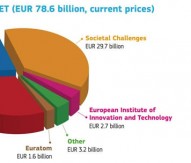

© European Association of Research and Technology Organisations
Reimbursing the reimbursement
Horizon 2020 introduces simplified rules for participation and streamlined funding mechanisms compared to the Seventh Framework Programme, with the European Commission promising to cut the time to grant by 100 days. The changes have been widely welcomed by both industry and scientists, yet could prove detrimental to one important group of researchers – the not-for-profit research and technology organisations (RTOs) and universities.
Under current proposals, projects will be able to receive reimbursement of up to 100% of direct, eligible costs, whilst closer-to-market ventures can receive a refund of up to 70% of costs. The Commission has also pledged to cover indirect costs (e.g. utility costs and other overheads) with a flat rate of 20% of the direct costs. The Council of the European Union has proposed to increase this contribution to 25%.
The Commission hopes these changes will help remove the financial complexities and errors that have plagued FP7 and many of its predecessors. Yet as Christopher Hull, secretary general of the European Association of Research and Technology Organisations, explains, present plans could have a significant and detrimental effect on participation.
What are your main concerns regarding the cost reimbursement proposals in Horizon 2020?
The flat rate contribution of 20% to indirect costs is probably correct for 90% or even 95% of the organisations that will participate in Horizon 2020. However, a critical 5% of organisations, including universities and non-profit RTOs, will find it difficult to participate, certainly as fully as they should do with this level of reimbursement. This 5% of organisations include many of the largest and most important players in the framework programme and have a lot to contribute to the aims of Horizon 2020, namely tackling socioeconomic challenges and supporting industrial leadership and economic competitiveness. Many of these players have very sophisticated equipment and cannot adequately fund their indirect costs with a 20% flat rate.
For many of my members (350 RTOs from across the EU and ‘FP-associated’ countries), this is their core business and they have a lot to contribute. What we would like to see is an option for real cost reimbursement, though keeping the flat rate as the default. Many universities have been moving towards full cost accounting for several years now and suddenly, in a sense, they have been told to stop. It is important that every serious research organisation (RTO or university) has a clear idea of its costs.
How optimistic are you that the funding rates will be changed to something more suitable for the various participants of Horizon 2020?
We are quietly confident that this will happen. We luckily have Christian Ehler MEP as the European Parliament’s rapporteur for the rules for participation. He has managed a network of high-tech incubators in Germany, so he knows about the world of research, innovation practices and related costs. He has been quite vocal against the Commission on the idea of a flat rate and that we need something that is more differentiated amongst participants.
At some point, there is going to have to be a compromise, and that point is coming quite close. There is a lot of pressure on everybody to wrap-up the big decisions on Horizon 2020 before the summer break. If that doesn’t happen before the start of the summer recess at the end of July, we are going to run into problems .There is a lot of implementing legislation that still needs to be passed so the programme can start on 1 January 2014. If these key decisions are not agreed and left until September, the start of Horizon 2020 will be delayed.
My quiet hope is that we will have a flat rate as the default, but there will be an option to have the real-cost reimbursement of indirect costs, perhaps limited to non-profit research organisations.
If things do not go the right way, what effect will that have on the participation of universities and RTOs?
It will ultimately mean the smaller participation of these organisations. It’s possible that in some countries, member states will provide some form of top-up funding so these organisations can continue to participate, but considering the budget cuts of many governments this will be difficult to implement.
It is simply a matter of economics – if you are being invited to contribute to a European research project, you have to fully consider your participation. There could be some additional strategic value or potential long-term gains to persuade you to become involved, yet if the funding isn’t sufficient to cover your costs, it makes the final decision very difficult.
I believe some people in the Commission, and maybe even in some member states, have forgotten that these funding programmes are incentive programmes – they don’t cover all your costs. Even today, they only cover nominally 75% of your eligible costs (if you are a non-profit research organisation) but remember that your eligible costs are not 100% of your total costs. In these circumstances, you may only be receiving a refund of 50% or less of your total, real costs. The remaining funding has to come from somewhere else (in some cases core funding or other co-funding from government).
These incentive programmes put significant, extra money on the table to encourage organisations to undertake original and innovative research projects they would probably not otherwise undertake, and that is something we must not forget.
Christopher Hull
European Association of Research and Technology Organisations


